
Philadelphus (mock-orange) is a genus of about 60 species of shrubs from 3–20 ft tall, native to North America, Central America, Asia and (locally) in southeast Europe.

Mahonia aquifolium, the Oregon grape or holly-leaved barberry, is a species of flowering plant in the family Berberidaceae, native to western North America. It is an evergreen shrub growing 1–3 meters tall and 1.5 m (5 ft) wide, with pinnate leaves consisting of spiny leaflets, and dense clusters of yellow flowers in early spring, followed by dark bluish-black berries.

Alstroemeria, commonly called the Peruvian lily or lily of the Incas, is a genus of flowering plants in the family Alstroemeriaceae. They are all native to South America, although some have become naturalized in the United States, Mexico, Australia, New Zealand, Madeira and the Canary Islands. Almost all of the species are restricted to one of two distinct centers of diversity; one in central Chile, the other in eastern Brazil. Species of Alstroemeria from Chile are winter-growing plants, while those of Brazil are summer growing. All are long-lived perennials except A. graminea, a diminutive annual from the Atacama Desert of Chile.

Pinus contorta, with the common names lodgepole pine and shore pine, and also known as twisted pine, and contorta pine, is a common tree in western North America. It is common near the ocean shore and in dry montane forests to the subalpine, but is rare in lowland rain forests. Like all pines, it is an evergreen conifer.

Dasiphora fruticosa is a species of hardy deciduous flowering shrub in the family Rosaceae, native to the cool temperate and subarctic regions of the northern hemisphere, often growing at high altitudes in mountains. Dasiphora fruticosa is still widely referenced in the horticultural literature under its synonym Potentilla fruticosa. Common names include shrubby cinquefoil, golden hardhack, bush cinquefoil, shrubby five-finger, widdy, and kuril tea.

Euonymus japonicus is a species of flowering plant in the family Celastraceae, native to Japan, Korea and China. It is an evergreen shrub or small tree growing to 2–8 m tall, with opposite, oval leaves 3–7 cm long with finely serrated margins. The flowers are inconspicuous, greenish-white, 5 mm diameter. In autumn, orange fruit hangs below the flaring pink seed coverings.

Abies lasiocarpa, the subalpine fir or Rocky Mountain fir, is a western North American fir tree.

Dicentra formosa is a flowering plant with fern-like leaves and an inflorescence of drooping pink, purple, yellow or cream flowers native to the Pacific Coast of North America.
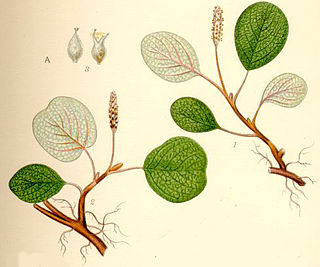
Salix reticulata, the net-leaved willow, or snow willow, is a dwarf willow, native to the colder parts of Europe, North America, and Northern Asia. It is found in the western United States, including the Sierra Nevada and Rocky Mountains. In Europe it extends south through the Carpathian Mountains and Alps to the Pyrenees and the mountains of Bulgaria and North Macedonia. It is common in Canada, Greenland and Finland, and present but rare in Scotland.

Lysichiton americanus, also called western skunk cabbage (US), yellow skunk cabbage (UK), American skunk-cabbage or swamp lantern, is a plant found in swamps and wet woods, along streams and in other wet areas of the Pacific Northwest, where it is one of the few native species in the arum family.
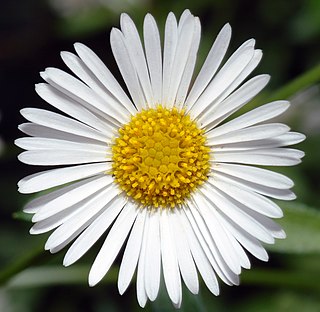
Erigeron karvinskianus, the Mexican fleabane, is a species of daisy-like flowering plant in the family Asteraceae, native to Mexico and parts of Central America.

Erigeron peregrinus is a North American species of flowering plants in the family Asteraceae known by the common name wandering fleabane.

Sambucus racemosa is a species of elderberry known by the common names red elderberry and red-berried elder.

Artemisia ludoviciana is a North American species of flowering plant in the daisy family Asteraceae, known by several common names, including silver wormwood, western mugwort, Louisiana wormwood, white sagebrush, lobed cud-weed, and gray sagewort.

Sedum spathulifolium is a species of flowering plant in the family Crassulaceae known by the common names broadleaf stonecrop, yellow stonecrop, and spoon-leaved stonecrop. An evergreen perennial, it is native to western North America from British Columbia to southern California, where it can be found often in shade in many types of rocky habitat in coastal and inland hills and mountains.
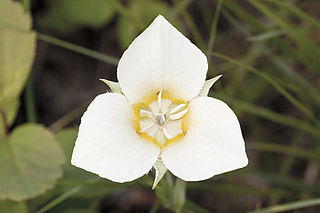
Calochortus apiculatus is a North American species of flowering plants in the lily family.

Erigeron filifolius is a North American species of flowering plants in the family Asteraceae known by the common names thread-leaf fleabane.
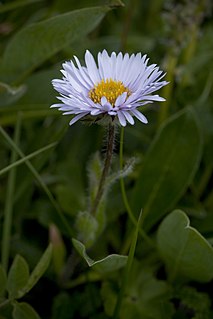
Erigeron grandiflorus is a North American species of flowering plant in the family Asteraceae known by the common names Rocky Mountain alpine fleabane and largeflower fleabane.

Erigeron poliospermus is a species of flowering plant in the family Asteraceae known by the common names gray-seeded fleabane and purple cushion fleabane. Native to western North America, it is mainly found in east of the Cascade Range in Washington, Oregon, and Idaho. A species of desert, scrub and rocky habitats below 1,800 metres (6,000 ft), it occasionally found at higher elevations.
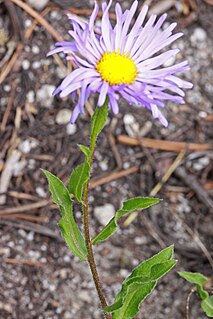
Erigeron subtrinervis, called the three-nerved daisy, the three-nerve fleabane, or the hairy showy daisy, is a North American species of flowering plants in the family Asteraceae. It grows in various mountains of western Canada and the western United States: Rocky Mountains, northern Cascades, Black Hills, etc., from British Columbia and Washington state east to North Dakota and south as far as New Mexico.




















